A rich harvest of tomatoes all year round: how to grow tomatoes on the balcony and what is needed for this
You don't have to have a garden to enjoy fresh homegrown tomatoes. After all, you can grow tomatoes in your apartment and then eat fresh vegetables.
We will tell you in this article how to grow tomatoes on the balcony at home and get a harvest.
Preparing the balcony for growing tomatoes
For growing tomatoes a balcony facing southeast or southwest is ideal. The north and south sides are not suitable for this. The fact is that in the first case the crop will not have enough sun, and in the second there will be an excess of sunlight.
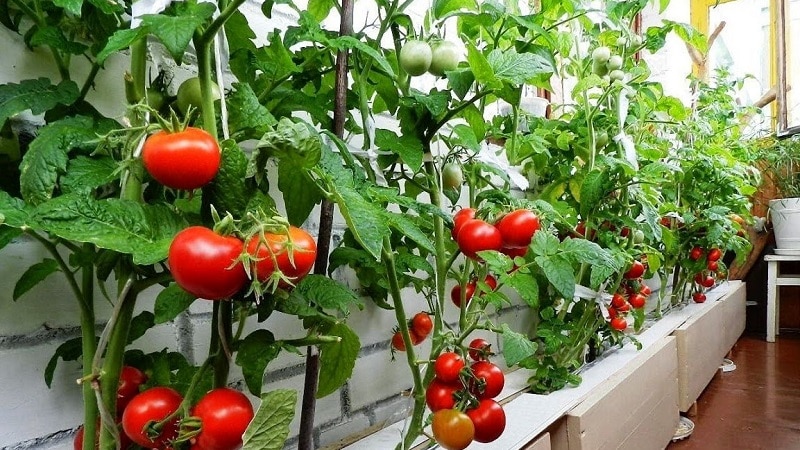
If the tomato pots are heavy, it is better to place them on the floor, closer to the wall or railings. It is worth considering that balcony tomatoes are afraid of drafts, which slow down their growth. Therefore, try to protect the plantings from gusts of wind as much as possible.
Important! On the balcony, tomatoes can be attacked by pests. To scare them away, it is advisable to plant spicy plants, such as mint, parsley or lettuce, next to the future harvest.
It is better to plant ampelous varieties in hanging pots. Place them so that it is convenient to water and care for plants. It is better to secure tall bushes to trellises made of rope or plastic.
Necessary conditions for cultivation
Tomatoes are very unpretentious to grow and they don't require much:
- light;
- warm;
- moisture;
- fertile land.
It is enough for tomatoes to be in the light 17 hours a day. If the bushes begin to stretch out and the root system develops poorly, it means that the plants do not have enough sun. To solve this problem, you can buy a special lamp in the store.
Important! Constant sunlight is detrimental to most tomato varieties.
Tomatoes do not require too high air temperature. During the day, 22–26 °C is enough for them, and at night they feel comfortable at a temperature of 16–19 °C. Overheating and hypothermia of plants will lead to their death or to the fact that they will not bear fruit. That is why it is important to maintain the temperature regime on the balcony. Humidity should not exceed 85% and it is undesirable for it to fall below 65%.

What varieties of tomatoes to choose for growing on the balcony
If the balcony is small, it is better to choose varieties of low-growing tomatoes. Such plants do not need to be tied up, and they are the easiest to care for. The short ones include:
- Button;
- Bonsai;
- Minibel;
- Balcony duet.
If the balcony is large, medium-sized or tall varieties of tomatoes are suitable. They are more difficult to care for, but they produce many times more harvest. These include:
- Oak;
- Balcony miracle;
- Cherry;
- Cherry black.
When choosing a variety, it is also important to consider the region of residence. For example, in cool climates with short summers, tomatoes often suffer from diseases, so it is better to choose varieties that are more disease-resistant.
Growing seedlings step by step
Phased the process of growing tomatoes on the balcony consists of the same steps, as cultivation in open ground. Obtaining seedlings is the very first stage. It is extremely important to approach it with maximum responsibility. Since tomatoes are not yet fully developed, they are very vulnerable.
Preparation of tomato seeds: disinfection and germination
It often happens that some planted seeds do not germinate or die early. To avoid this it is better cull planting materialand then disinfect it.
First of all, start by selecting the seeds. To do this, scatter them in front of you and carefully examine them. Damaged or having an uncharacteristic color throw it away immediately.
Important! Encrusted and pelleted seeds do not need to be checked or soaked; the manufacturer himself selects the material suitable for planting.
The shells of future tomatoes may contain viruses and fungi that are harmful to plants. To reduce the number of pathogenic bacteria, it is better to disinfect the seeds.
This is usually done according to the following instructions:
- All seeds that have passed the selection are placed in gauze or bandage.
- The bag is carefully lowered into a solution of a fungicide or antiseptic (you can use a weak solution of potassium permanganate or hydrogen peroxide).
- Keep the seeds in the solution for 15–20 minutes.
- Then take it out and dry it.
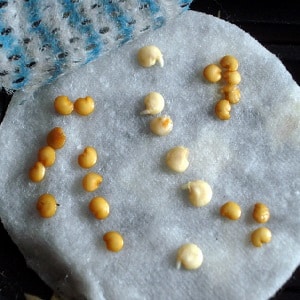 To speed up the emergence of seedlings, as well as check the viability of seeds, they are germinated. And not in the ground, but on cotton pads or gauze:
To speed up the emergence of seedlings, as well as check the viability of seeds, they are germinated. And not in the ground, but on cotton pads or gauze:
- Cotton pads are moistened in water.
- Place tomato seeds on them.
- Place another damp cotton pad on top.
- Place in a plastic container with a lid.
- The container is placed in a warm place with a temperature of +20…+25 °C.
Tomato seeds hatch within three days. You can tell that the seed has opened by looking at the white root. It is important not to let the root grow into the cotton pad, otherwise it will be impossible to remove it without damaging the root system. Therefore, two days after the root appears, it is necessary to plant the seeds in the ground.
Soil preparation
Buy soil or make it yourself, mixing equal parts of fertile soil, peat and sand. It is better to buy special soil for tomatoes. It contains all the necessary substances. To improve the looseness of the soil, sawdust or peat is added to it.
Before planting seeds, the soil is calcined in the oven or spilled with a solution of potassium permanganate.
Sowing seeds
It is better to plant seeds in containers no more than 8 cm high.. Pre-prepared soil is poured into containers and watered with warm water.
After this, grooves are made 1 cm deep. The distance between two grooves is at least 4 cm. Seeds are placed in the recess at a distance of 2 cm from each other. Then the grooves are sprinkled with earth, the box is covered with film and placed in a warm, but not hot place.
Caring for seedlings: watering and other activities
 The soil must be kept moist. When the first shoots hatch, remove the film from the box and place the seedlings in a sunny place.
The soil must be kept moist. When the first shoots hatch, remove the film from the box and place the seedlings in a sunny place.
Now you can gradually harden off the plants. On warm days, the windows on the balcony open for a few hours. However, it is important to close the doors tightly at night.
Do not forget about loosening the soil. This procedure allows you to maintain the aerating properties of the soil. It is important to do this as carefully as possible, without going too far from the surface, so as not to damage the root system.
In the second week, the seedlings begin to be fertilized. The day before, the soil must be watered. The next feeding is carried out after 10 days.
Transplanting seedlings and caring for plants
It is better to transplant seedlings into larger pots after the seedlings reach a month of age. During this time, about five leaves are formed on the sprouts. After a successful transplant, it is important to properly care for your tomatoes.. Then they will give a good harvest.
Selecting soil and container
If you decide to transplant tomatoes into a long container, there should be at least 30 cm between them. Otherwise, the seedlings will interfere with each other when they grow up. This will lead to a decrease in yield or even death of some bushes.
Expanded clay must be placed at the bottom of the container or broken tiles to ensure good drainage. Instead of a container, you can use almost any container, including flower pots. The size of the pot is selected so that the roots have enough space to develop. The volume should be at least 5 liters for short-growing tomatoes and at least 20 liters for tall-growing tomatoes.
Important! The container chosen for tomatoes must have a hole in the bottom to drain excess water.
It is advisable to saturate the soil with organic fertilizers. However, in special stores you can find soil that has already been fertilized.
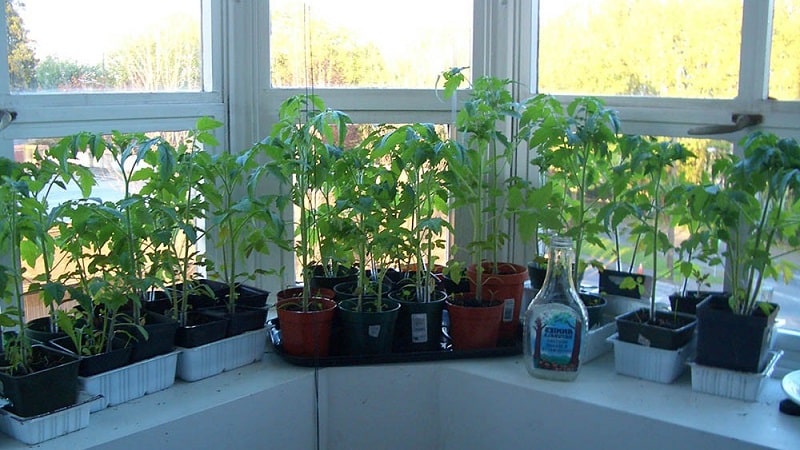
Transplanting tomatoes into permanent containers
If you are transplanting for the first time, be prepared for the fact that some seedlings may not take root. To avoid this, it is important to do everything as carefully as possible without harming the root system:
- Fill the selected pot about a third with soil.
- Place the seedling on the ground and straighten the roots.
- Press them slightly to the ground.
- Now gradually pour the soil into the pot and gently press it down.
- Fill the pot about 2/3 full. Remember to lift the plant so as not to fall asleep.
- Lightly compact the soil.
- Water the seedlings with warm water. It is important to do this gradually so that all the moisture is absorbed.
After transplanting, it is not advisable to touch tomatoes for a week.. You need to give them time to get accustomed.
Formation of a bush: how to properly perform pinching
Pinching is the removal of tomato shoots, grown between the main stem and side leaves of the plant. This procedure is carried out at all stages of the plant’s life. The stepsons are removed with pruning shears or simply broken off.
To get a good tomato harvest, bushes form three or fewer stems. It is best to pinch the branches before they grow more than 4-5 cm.

When and what to feed tomatoes
It is better to feed tomatoes with organic matter. After it, they begin to grow quickly and then actively bear fruit. Such fertilizers include diluted chicken manure or mullein. However, urban residents prefer to buy mineral complexes. Before using them, be sure to read the instructions for use.
Pollination: is it necessary indoors?
Pollination required for tomatoes to set fruit. There are several ways to artificially pollinate them. It's better to do this in the morning.
Important! Pollination requires moisture, so it is better to water or spray the bush in advance.
You can open a window or install a fan, thereby creating an imitation of wind. It should be borne in mind that cold air from an open window can damage the tomatoes.
Also you can gently tap the stemso that the pollen moves to the stigmas. If you want to be sure to pollinate the bushes, purchase a special device for pollinating tomatoes.
Watering
Water the bushes as the top layer of soil dries out. The water temperature should be warm or room temperature. If the stage of fruit set has arrived, you can water the tomatoes only in the evening. Otherwise, the pollination process can be disrupted.
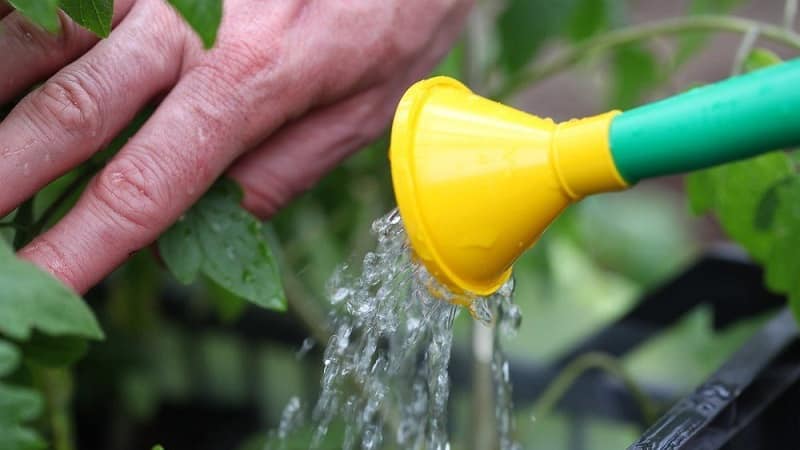
Problems with growing indoor tomatoes, pests and diseases
Tomatoes grown on the balcony are more likely to get sick fungal diseasesthan tomatoes that grow in open ground. To avoid infection, you need to ventilate the room more often, but you should not allow hypothermia. It is also advisable to spray the bushes with Bordeaux mixture once a month.
Balcony tomatoes are also threatened insects. Spider mites and whitefly. It is better to use “Akavir” or “Borneo” against the first one, and “Inta-vir” is suitable for whiteflies. You can buy them at any gardening store.
Tomato flowering and harvest
Tomatoes are harvested as they ripen. If the tomato is already red, it is better to pick it to allow others to ripen. If the tomato is not yet ripe, but you have already picked it, put it in a warm place to ripen.
Growing tomatoes in plastic bottles
Growing tomatoes in bottles was invented a long time ago. Almost any plastic container is suitable for this. The main thing is that its volume is at least 5 liters. This method is very convenient and practical, since there is no need to grow seedlings in advance; the seeds can be immediately planted in a bottle, where they grow into full-fledged bushes.
Important! Make small slits in the bottom of the container to allow excess water to drain out when watering.
Seeds are sown in a bottle in the same way as in a regular pot.. After the first shoots appear, it is better to place the seedlings in a lighted place. Plants in bottles are watered and fed according to the same instructions as described above for tomatoes in pots.
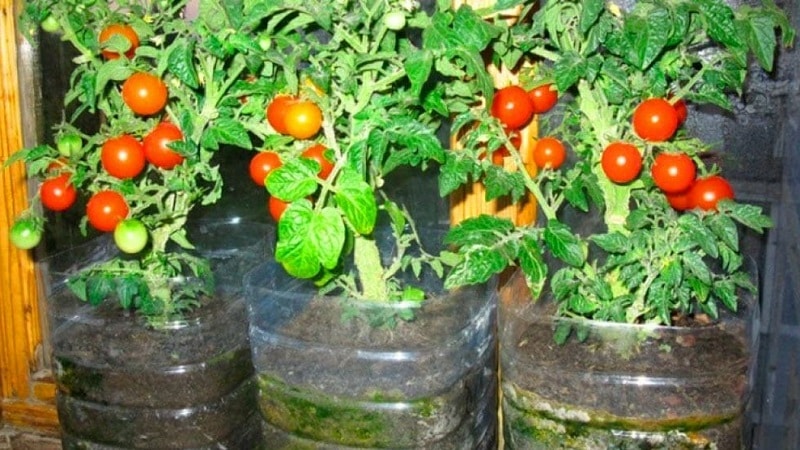
Possible problems
Mostly problems arise due to improper care for plants. So, they should not be watered abundantly, but they should not be allowed to dry out. Lack of sunlight reduces the viability of tomatoes.
Also it is important to give the plants enough space to develop, otherwise the neighbors’ roots will intertwine and interfere with each other. The stem and leaves become weak when there are not enough microelements in the soil.
Features of growing tomatoes on an open and glazed balcony
You can grow tomatoes on an open balcony only in the warm seasonwhen the temperature at night does not drop below +8 °C. A special canopy will be required to protect the plants from precipitation and wind. If it is not possible to make this design, it is better to bring the bushes into the house in bad weather.
The glass balcony allows you to grow tomatoes even in winter. However, you need to try to ensure that the room is well insulated and has a constant temperature. At the same time, there should be good ventilation there.

Tips and tricks for growing
You need to arrange pots with bushes so that everyone had access to sunlight, and you could go near any plant.
If the air on the balcony is dry, it needs to be humidified. For example, fill a basin with cool water and place it next to the pots. There is no need to spray the tomatoes themselves.
As soon as the first signs of the disease appeared tomatoes, you need to start treatment immediately.
Conclusion
Growing tomatoes on your balcony is not at all difficult. It is important to properly prepare the balcony, plant the seedlings, and then transplant them into larger pots without harming the plants. Proper care of tomatoes will ensure a bountiful harvest and will allow you to have fresh vegetables on the table without going to the store.